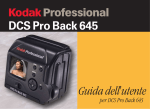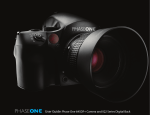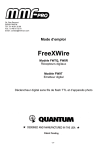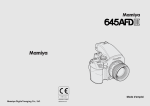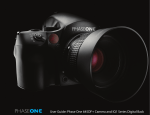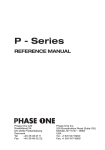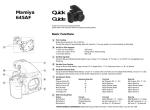Download Phase One M645 User's Manual
Transcript
H 10 M645 GETTING STARTED Phase One A/S Roskildevej 39 DK-2000 Frederiksberg Denmark Tel +45 36 46 01 11 Fax +45 36 46 02 22 Phase One U.S. 24 Woodbine Ave Northport, New York 11768 USA Tel +00 631-757-0400 Fax +00 631-757-2217 Notice The name Phase One is a trademark of Phase One A/S. The names Apple Macintosh, Mamiya, Microsoft Windows and Adobe Photoshop are all registered trademarks of their respective companies. All specifications are subject to change without notice. Phase One takes no responsibility for any loss or damage sustained while using their products. This manual ©2002, Phase One A/S Denmark. All rights reserved. No part of this manual may be reproduced or copied in any way without prior written permission of Phase One. Printed in Denmark. Part #: 80013001 Table of Contents 1 Contents 1 Introduction . . . . . . . . . . . . . . . . . . . . . . . . . . . . . . . . . . . . . . . . . . .2 2 Special H 10 M645 features . . . . . . . . . . . . . . . . . . . . . . . . . .3 Auto exposure . . . . . . . . . . . . . . . . . . . . . . . . . . . . . . . . . . . . . . . .3 Double exposure protection . . . . . . . . . . . . . . . . . . . . . . . . . . . . . . .4 Image orientation detection . . . . . . . . . . . . . . . . . . . . . . . . . . . . . .4 IR filter on the CCD. . . . . . . . . . . . . . . . . . . . . . . . . . . . . . . . . . . . . .5 3 Getting ready for taking pictures . . . . . . . . . . . . . . . . . . . . .6 Mounting the viewfinder mask . . . . . . . . . . . . . . . . . . . . . . . . . . . .6 Mounting the H 10 M645 on the Mamiya 645AF . . . . . . . . . . . . . .7 Use of cables . . . . . . . . . . . . . . . . . . . . . . . . . . . . . . . . . . . . . . . . . .8 Using manual focus lenses . . . . . . . . . . . . . . . . . . . . . . . . . . . . . . . .9 4 Maintenance . . . . . . . . . . . . . . . . . . . . . . . . . . . . . . . . . . . . . . . . .10 Cleaning the IR filter . . . . . . . . . . . . . . . . . . . . . . . . . . . . . . . . . . . .10 Cleaning between the IR filter and the CCD . . . . . . . . . . . . . . . . . .10 5 Current limitations . . . . . . . . . . . . . . . . . . . . . . . . . . . . . . . . . . .11 Continuos capture mode . . . . . . . . . . . . . . . . . . . . . . . . . . . . . . . .11 6 Technical data . . . . . . . . . . . . . . . . . . . . . . . . . . . . . . . . . . . . . . . .12 1 H 10 M645 Getting Started 1 Introduction The H 10 for M645 is a single shot digital camera back for the innovative Mamiya 645 AFD camera. The Mamiya 645 utilises a hybrid TTL phase-difference-detection type autofocus system. Further more the Mamiya 645AF provides auto exposure settings. The Mamiya 645AFD with a H 10 M645 back encourages all kinds of photographic uses from portraiture and wide-angle photography to high speed shooting to capturing fast action with telephoto lenses. This exiting combination is a result of a joint development project between Phase One and Mamiya-OP. The functionality of the H 10 M645 is well integrated with the Mamiya 645AFD camera. The H 10 M645 camera back communicates with the Mamiya camera through a fast internal electrical computer interface. The H 10 M645 is based on the highly recognised Phase One camera back technology. The application software for the H 10 M645 is the same as for all other Phase One single shot products. The Capture One User Guide is a general manual for these products. This Manual “H 10 M645 - Getting Started” covers only specific H 10 M645 features and functionality. 2 H 10 M645 Getting Started 2 Special H 10 M645 features Auto exposure The Mamiya 645AFD can work in different auto exposure modes. This is fully supported by the H 10 M645, which communicates the equivalent film speed of the digital back to the Mamiya 645AFD camera. The default film speed of the H 10 M645 camera back is ISO 50. However this setting can be changed to 100, 200 or even 400 ISO, inside the Capture One application. It is recommended to capture images using a film curve. That is done by selecting the film curve in the Capture One software. Click the camera icon in the icon bar, and select “Film Curve” or “Film Curve, Natural Black”. When capturing with auto exposure modes, exposures between 1/4000 sec. and 30 sec can be obtained. Please note that images captured with exposure times longer than 2 sec. can be degraded because of increased digital noise. 3 H 10 M645 Getting Started Double exposure protection When using the M645 with a H 10 M645 it is not possible to accidently double expose the image by capturing one image quickly after another. The H 10 communication with the M645 is disabling capture functionality in the camera when necessary. At the end of an image exposure the image information in the CCD has to be moved from the CCD to the host computer. During this short period of time the CCD must be protected from light exposure. The H 10 M645 ensures a safe emptying of the CCD by ignoring the shutter release from the Mamiya camera. Image orientation detection The CCD in H 10 M645 is positioned in landscape orientation. Whenever an image is captured in portrait position by rotating the camera, an internal sensor detects this new position and the image will appear as a correctly oriented image in the Capture One application. Camera orientation: Images can be captured in all three positions - and will appear with the correct orientation in the Capture One software. 4 H 10 M645 Getting Started IR filter on the CCD The IR filter (Phase One TG1 Infrared cut-off filter) is placed on top of the CCD. The filter may not be removed for several reasons. l l l The focusing of the H 10 camera back will be damaged It is only possible to remount the filter without dust in between the filter and the CCD if you have access to special clean room facilities. The Phase One Product Warranty is terminated. 5 H 10 M645 Getting Started 3 Getting ready for taking pictures Mounting the viewfinder mask The image area of the Mamiya 645AF is approximately 6 cm x 4.5 cm. The image area of the H 10 M645 is 2.4 cm x 3.6 cm. A H 10 M645 viewfinder mask is provided. This mask has to be mounted beneath the original focusing screen. The viewfinder mask is positioned in the bracket that holds the focusing screen. Please refer to the Mamiya 645 AFD Instructions “Changing the focus screen” before the focus screen is mounted. The black mark on the mask must be orien tated to the left front corner of the bracket. 6 H 10 M645 Getting Started Mounting the H 10 M645 on the Mamiya 645AFD The H 10 M645 is fully integrated with the camera house and acts as a true part of the whole camera system. When no cassette is attached to the Mamiya 645 AF camera house the mirror is up and the shutter is open. This is the correct position, when no film cassette is attached. When attaching the M645 to the camera house, the shutter will close and the mirror comes down. It is important to ensure that the bottom part of the H 10 M645 camera back is pressed well into the locking mechanism before the upper locking mechanism is pressed together. Failure to do this can in some circumstances bring the Mamiya camera house in an error state of continuos opening and closing the shutter. (The same procedure is recommended for all film cassettes). In case this error appears you simply have to remove the H 10 M645. Notice if the shutter is in the closed position, attach and remove the H 10 to make sure that the camera house gets in the correct starting position. To avoid that the H 10 is released by mistake from the camera house, you can use the enclosed screwdriver to lock the H 10 M645 locking mechanism. Step 1 Step 2 Step 3 7 H 10 M645 Getting Started Use of cables Using auto focus lenses: No cables are required between the H 10 M645 and the Mamiya 645AFD when auto focus lenses are used. Flash sync cable must be connected to the Mamiya 645AFD camera house. CORRECT When using AF lenses the flash sync cable must NOT be connected to the camera back. NOT CORRECT 8 H 10 M645 Getting Started Using manual focus lenses: The provided short flash sync cable shall be con nected between the “C” plug on the H 10 M645 and the lens sync plug. The flash system sync cable shall be connected to the H 10 M645 “F” plug. Only exposure times between 1/250 sec. and 30 sec. are supported. When using a manual-focus lens in continuous light you must manually compensate for a small underexposure i.e. with the setting of the aperture: Exposure time 1/60 sec 1/125 sec 1/250 sec Loss in exposure 1/3 f-stop 1/2 f-stop 1 f-stop Operating the camera from the host computer: The supplied motor cable must be connected between the “M” connector on the H 10 M645 and the 8-pin connector on the Mamiya camera house. AF-lenses as well as manual focus lenses can be used. 9 H 10 M645 Getting Started 4 Maintenance Cleaning the IR filter When the H 10 M645 camera back is not attached to a Mamiya camera, the camera back shall be protected with the protection plate. Still dust particles can stick to the IR filter. This will degrade the image quality. The cleaning procedure for cleaning the IR filter is described in the guidelines for the CCD cleaning kit that came with your camera back. Cleaning between the CCD and the IR filter Do not try to clean between the CCD and the IR filter! The mounting of the IR filter is done at the factory in a highclass clean room. This process is a very specialised process that insures an extremely high quality of the glass surfaces of the CCD and the IR filter. The screws for locking the IR filter are sealed. If the seal is broken Phase One will not guarantee for any particles between the CCD and the IR filter. 10 H 10 M645 Getting Started 5 Current limitations Continuous capture mode Continuous capture mode will work as single exposure mode. Keeping the release bottom down will only result in one exposure. The release button has to be depressed between exposures. 11 H 10 M645 Getting Started 6 Technical data l l Single shot camera back for Mamiya 645AFD l Electrical computer interface between H 10 M645 and Mamiya 645AFD Full support for Mamiya lenses (1/4000 - 30 sec.) l l Electronic protection against double exposure Orientation sensor for correct display of landscape and portrait images Resolution: 3992 x 2656 pixels Image modes: RGB, Grey or CMYK Pixel depth: 3 x 8 bit or 3 x 16 bit for RGB 8 bit or 16 bit for Grey 4 x 8 bit or 4 x 16 bit for CMYK Image area: 24.6 mm x 36.9 mm (1” x 1.5”) Computer connection: IEEE 1394 Power consumption: 7 watt Compatible strobe systems: When using Auto-Focus lenses, please refer to the Mamiya documentation. 12 H 10 M645 Getting Started 13















